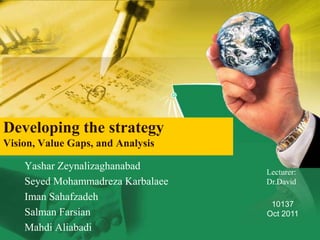
Developing the strategy
- 1. Developing the strategy Vision, Value Gaps, and Analysis Yashar Zeynalizaghanabad Lecturer: Seyed Mohammadreza Karbalaee Dr.David Iman Sahafzadeh 10137 Salman Farsian Oct 2011 Mahdi Aliabadi
- 3. Developing the strategy • Defines the organization’s purpose and goals and carefully examines the external and internal environment to identify opportunities and constraints regarding that strategy. • The strategy development practices followed by the most successful organizations. (A 2006 McKinsey survey) • The systematic strategic development process follow by four steps: • Part 1 – Crafting mission , vision and value statement – Strategic goals – Strategic analysis • Part 2 – Formulating and launching the strategy
- 4. These four strategy development steps address the following four questions: 1. What business are we in and why? 2. Where are we going ? 3. What are the key issues that or strategy must address? 4. How can we best compete?
- 6. Vision, Mission & value
- 7. Mission The mission is a brief , typically one-sentence , statement that defines the fundamental purpose of the organization. Defines what the organization provide to its clients and Inform executives and employees about the overall goal that they have to pursue.
- 8. Value • The value of a company prescribe its desired behavior , character , and culture. • Example: “selling the highest quality natural and organic products available “ “supporting team member excellence and happiness” “caring about our communities and our environment “
- 9. Vision • The vision is a concise statement that defines the mid-to long- term(three to ten years) goals of an organization. • Characteristics of vision : – External – Market oriented – Express preferably in clear, specific aspirational terms – Measurable
- 10. Quantifying the vision • A quantified vision provides a clear focus for the strategy by including a measurable outcome and a targeted value. • Three essential components of a good vision statement : – A quantified success indicator – A definition of niche – A time line for execution • Example 1 : – The vision statement of CIGNA property & casualty : “ to be a top quartile specialist within five years” • Example 2 : – John F. Kennedy vision for US space program “to land a man on the moon and return him safely to earth before the end of the decade” • Example 3 : – Leeds University (UK) “by 2015 , our distinctive ability to integrate world class research scholarship and education will have secured us a place among the top 50 universities in the world”
- 11. The benefits of vision Increase the clarity of the message Adds a discrete definition of success that can be cascaded to lower organizational level Establishes a time frame in which the success will occur Sets an ambitious target for the strategy at the highest organizational level and early in the planning process Stability of mission, vision, and value
- 12. Enhancing the vision The enhanced version moves the vision beyond a simple outcome statement of the vision.
- 13. Strategic goals : define and decompose the value gap • The value gap represents the difference between aspiration and reality; it becomes the goal for the new strategy to fulfill. • The value gap represents the difference between the desired outcome and what could be achieved by maintaining the status quo with the existing strategy. • The key financial measure is combined ratio
- 14. Example • Leeds University • CIGNA
- 16. Strategic analysis External analysis • PESTEL Assesses the macroeconomic environment. Reflecting its political , economic , social , technological , environmental and legal components. • Michael porter’s five forces model Industry level examination of industry economics using Porter’s five force model: The bargaining power of buyers and suppliers, the availability of substitute , the threat of new entrants , and intensity of industry rivalry.
- 17. Internal analysis • The internal analysis examines and an organization’s own performance and capabilities • The value chain model – Primary – Secondary
- 18. •SWOT analysis Identifies the company’s –Existing strengths and weaknesses (internal attributes) –Emerging opportunities and worrisome threats (external attributes) SWOT analysis help summarize the external and internal analysis information into a brief list. •BSC SWOT Matrix -Created by performing a SWOT analysis for each of the BSC perspectives, Provides a frame work that integrates the SWOT strategy planning tools.
- 19. Formulating and lunching the strategy • Strategy formulation – The stage of strategic management that involves the planning and decision making that leads to the establishment of the organization’s goals and of a specific strategic plan 1. Corporate ( What business are we in ?) 2. Business (How do we compete? ) 3. Functional (How do we support the business-level strategy )
- 20. Strategy Implementation • The stage of strategic management that involves the use of managerial and organizational tools to direct resource toward achieving strategic outcomes . 1. Leader ship/Culture 2. Structure 3. Human resource 4. Information and control system
- 21. Conclusion For developing strategy we must follow steps Mission Fundamental , Overall purpose 1. Defining Vision External, Market oriented, Measurable Value behavior , character 2. Strategic the goals Transmit from aspiration to reality Internal 3. Strategic analysis External 4. Formulating the strategy